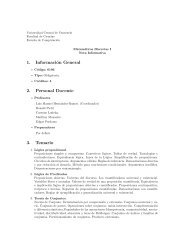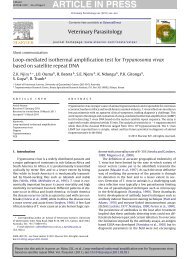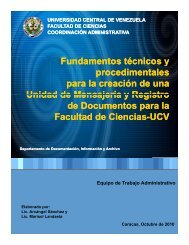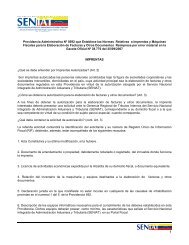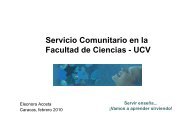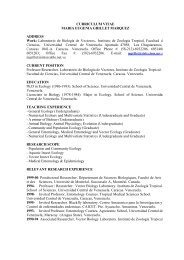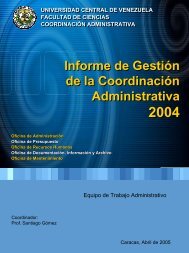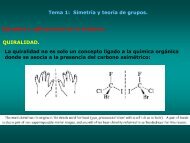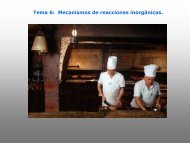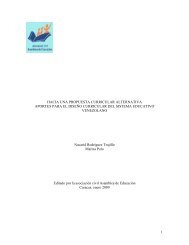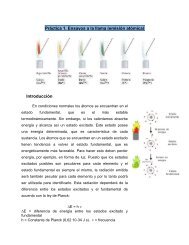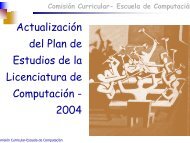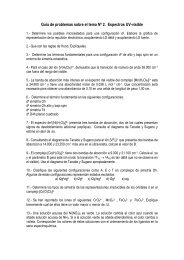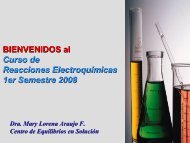pictures of several types of traps used.Stanley, J. M., <strong>and</strong> C. B. Dominick. 1970. Funnel size <strong>and</strong>lamp wattage influence on light-trap performance. J.Econ. Entomol. 63:1423 1426.__________ <strong>and</strong> others. 1977. Electrocutor grid insecttraps for research purposes. Am. Soc. Agr. Engin.Trans.20:175-178.Steck, W., <strong>and</strong> B. K. Bailey. 1978. Pheromone traps formoths: Evaluation of cone trap designs <strong>and</strong> designparameters. Environ. Entomol. 7:419-455.Stein, J. D. 1976. Insects: A guide to their collection,identification, preservation <strong>and</strong> shipment. U.S. Dept.Agr., Forest Serv., RM-311, 12 pp.Stein, R., <strong>and</strong> others. 1968. Extraneous materials. Stainingtechnique to differentiate insect fragments, birdfeathers, <strong>and</strong> rodent hairs from plant tissue. J. Assoc.Off. Anal. Chem. 51:513-518.Stewart, J. W., <strong>and</strong> T. L. Payne. 1971. Light trap screeningfor collecting small softbodied insects. Entomol.News 82:309-311.Stewart, P. A., <strong>and</strong> J. J. Lam. 1968. Catch of insects atdifferent heights in traps equipped with blacklightlamps. J. Econ. Entomol. 61:1227-1230.Steyskal, G. C. 1957. The relative abundance of flies(Diptera) collected at human feces. Ztschr. f. Angew.Zool. 44:79-83.__________ 1977. History <strong>and</strong> use of the McPhail trap.Fla. Entomol. 60:11-16.__________ 1981. Bibliography of the Malaise trap.Proc. Entomol. Soc. Wash. 83:225-229.Steyskal, G. C., W. L. Murphy, <strong>and</strong> E. M. Hoover, Eds.1986. Insects <strong>and</strong> mites: Techniques for collection<strong>and</strong> preservation. U.S. Department of Agriculture.Misc. Pubs. no. 1443, 103pp.Still, G. W. 1960. An improved trap for deciduous treefruit flies. J. Econ. Entomol. 53:967.Str<strong>and</strong>tmann, R. W., <strong>and</strong> G. W. Wharton. 1958. Manual ofmesostigmatid mites parasitic on vertebrates. Univ.Md. Inst. Acarol. Contrib. 4:1-330.Strang, T. J. K. 1992. A review of of published temperaturesfor control of pest insects in museum. CollectionForum 8:41-67.Strang. T. J. K. 1992. Museum Pest Management.Appendix C. In: S. Michalski (Ed.) A systematicapproach to the conservation (care) of museumcollections with technical appendices. Produced bythe Canadian Conservation Institute for the Int.Symp., First World Congr. Pes. & Cons. Nat. Hist.Coll., Madrid, 1992.Strenzke, K. 1966. Empfohlene Methodenzur Aufzuchtund Präparation terrestrischer Chironomiden.Gewaess. Abwaess. 41/42:163 168. Methods forrearing <strong>and</strong> preparation of terrestrial Chironomidae(Diptera).Stryker, R. G., <strong>and</strong> W. W. Young. 1970. Effectiveness ofcarbon dioxide <strong>and</strong> L (+) lactic acid in mosquito lighttrap with <strong>and</strong> without light. Mosq. News 30:388-393.<strong>Collecting</strong> <strong>and</strong> <strong>Preserving</strong> Insects <strong>and</strong> MitesStubbs, A., <strong>and</strong> P. Ch<strong>and</strong>ler, eds. 1978. A dipterist'sh<strong>and</strong>book. V. 2. The amateur entomologist. 255 pp. J.Amateur Entomol. Soc., Hanworth, Engl<strong>and</strong>. <strong>Collecting</strong><strong>and</strong> recording, pp. 1-37.Tagestad, A. D. 1974. A technique for mounting Microlepidoptera.J. Kans. Entomol. Soc. 47:26-30.__________ 1977. Easily constructed individual mountingblocks for macro- <strong>and</strong> microlepidoptera. J. Kans.Entomol. Soc. 50:27-30.Takeda, U., <strong>and</strong> others. 1962. Studies on a collectionmethod of mosquitoes by dry ice <strong>and</strong> a mosquito net.Jap. J. Sanit. <strong>and</strong> Zool. 13:31-35. [In Japanese withEnglish summary.]Tarshis, I. B. 1968. Use of fabrics in streams to collectblackfly larvae. Ann. Entomol. Soc. Am. 61:260-261.__________ 1968. <strong>Collecting</strong> <strong>and</strong> rearing blackflies. Ann.Entomol. Soc. Am. 61:1072-1083.Taylor, L. R. 1962. The absolute efficiency of insectsuction traps. Ann. Appl. Biol. 50:405-421.Taylor, L. R. 1962. The efficiency of cylindrical stickyinsect traps <strong>and</strong> suspended nets. Ann. Appl. Biol.50:681-865.Tedders, W. L., <strong>and</strong> G. W. Edwards. 1972. Effects ofblacklight trap design <strong>and</strong> placement on catch of adulthickory shuckworms. J. Econ. Entomol. 65:1624-1627.Teskey, H. J. 1962. A method <strong>and</strong> apparatus for collectinglarvae of tabanid (Diptera) <strong>and</strong> other inhabitants ofwetl<strong>and</strong>. Proc. Entomol. Soc. Ontario 92:204-206.Thomas, D. B., <strong>and</strong> E. L. Sleeper. 1977. Use of pit-falltraps for estimating the abundance of arthropods, withspecial reference to the Tenebrionidae (Coleoptera).Ann. Entomol. Soc. Am. 70:242-248.Thompson, P. H. 1969. <strong>Collecting</strong> methods for Tabanidae(Diptera) <strong>and</strong> other inhabitants of wetl<strong>and</strong>. Proc.Entomol. Soc. Ontario 92:204-206.Thomas, D. B., <strong>and</strong> E. L. Sleeper. 1977. Use of pit-falltraps for estimating the abundance of arthropods, withspecial reference to the Tenebrionidae (Coleoptera).Ann. Entomol. Soc. Am. 70:242-248.Thompson, P. H. 1969. <strong>Collecting</strong> methods for Tabanidae(Diptera). Ann. Entomol. Soc. Am. 62:50-57.__________ <strong>and</strong> E. J. Gregg. 1974. Structural modifications<strong>and</strong> performance of the modified animal trap <strong>and</strong>the modified Manitoba trap for collection of Tabanidae(Diptera). Proc. Entomol. Soc. Wash. 76:119 122Thorsteinson, A. J., B. G. Bracken, <strong>and</strong> W. Hanec. 1965.The orientation behavior of horse flies <strong>and</strong> deer flies(Tabanidae: Diptera). III. The use of traps in the studyof orientation of tabanids in the field. Entomol. Exp.et Appl. 8:189-192.Tindale, N. B. 1962. The chlorocresol method for fieldcollecting. J. Lepid. Soc. 15:195-197.Torre-Bueno, J. R. de la. 1937. A glossary of entomology.336 pp., 9 pls. Brooklyn Entomol. Soc., New York.(2d printing, 1950.)64
Townes, H. K. 1972. A light weight Malaise trap. Ent.News. 83:239-267.Traver, J. R. 1940. Compendium of entomologicalmethods. Pt. l. <strong>Collecting</strong> mayflies (Ephemeroptera). 7pp. (unnumbered). Ward's Nat. Sci. Estab., Rochester,N.Y.Tretzel, E. 1955. Technik und Bedeutung des Fallenfangesfür ökologische Untersuchungen. [Technique <strong>and</strong>significance of the pitfall trap for ecological research.]Zool. Anz. 155:276-287.Turnbull, A. L., <strong>and</strong> C. F. Nicholls. 1966. Quick trap forarea sampling of arthropods in grassl<strong>and</strong> communities.J. Econ. Entomol. 59:1100-1104.Turnock, W. J. 1957. A trap for insects emerging from thesoil. Can. Entomol. 89:455-456.Upton, M. S. 1991. Methods for collecting, preserving,<strong>and</strong> studying insects <strong>and</strong> allied forms. Austr. Entomol.Soc. Misc. Pub. 3, 4th ed. Brisbane. 86pp.U.S. Department of Agriculture, Agricultural ResearchService. 1961. Response of insects to induced light.Presentation papers. U.S. Dept. Agr., Agr. Res. Serv.,ARS 20-10, 66 pp. Includes 11 pp. of bibliography oninsects <strong>and</strong> light.U.S. Department of Agriculture, Extension Service. 1970.4-H Clubs entomology publications (loose leaf, in 4pts.): 1, How to make an insect collection; 2, Key toorders, rearing cages, experimental activities; 3, Teen<strong>and</strong> junior leader's guide; 4, Refererice material.U.S. Department of Agriculture, Plant Pest ControlDivision. 1966 70. Survey methods; selected references1942-1970. Pts. 1-35. USDA Coop. Econ. InsectRep. 17:97-112, 326-336, 862-868, 977-982, 10711076; 18:70-72, 369-376, 564-568, 746-750, 911-914,969-974, 990 996, 1054-1058, 1103-1106; 19:88-96,335-337, 353-354, 505-506, 785-786, 797-798, 838-842, 865-870; 20:11-12, 34-36, 43-44, 151 152, 207-208, 239-242, 345-346, 527-528, 727-732, 763-767;21:35 40, 87-94; 22:285-298. References categorizedinto population measuremeet, forecasting, rearing,equipment <strong>and</strong> technology, traps, attractants, <strong>and</strong>pictorial keys. The various parts are not in chronologicalorder.Urquhart, F. A. 1965. Introducing the insect. 258 pp.Frederick Warne, London. Elementary directions formaking insect collections, pp. 1 19.Usinger, R. L., ed. 1956. Aquatic insects of Californiawith keys to North American genera <strong>and</strong> Californiaspecies. 508 pp. Univ. Calif. Press, Berkeley.Van Cleave, J., <strong>and</strong> J. A. Ross. 1947. A method ofreclaiming dried zoological specimens. Science105:318.Van den Berghe, E. 1992. On pitfall trapping invertebrates.Ent. News 103(4): 149-156.van Noort, S. A simple yet effective method for dryingalcohol preserved specimens. Chalcid Forum 18: 3-4.Wagstaffe, R., <strong>and</strong> J. H. Fidler. 1955. The preservation ofnatural history specimens. V. 1. Invertebrates. 205 pp.Techniques <strong>and</strong> ToolsPhil. Libr., New York.Walker, A. R., <strong>and</strong> P. F. L. Boreham. 1976. Saline, as acollecting medium for Culicoides (Diptera:Ceratopogonidae) in blood-feeding <strong>and</strong> other studies.Mosq. News 36:18-20.Walker, T. J. <strong>and</strong> B. Lenczewski. 1989. An inexpensiveportable trap for monitoring butterfly migration. J.Lepid. Soc. 43: 289-298.Walker, T. J. <strong>and</strong> J. J. Whitesell. 1993. A superior trap formigrating butterflies. J. Lepid. Soc. 47: 140-149._______. 1994. A simple portable trap for migratingbutterflies. J. Lepid. Soc. 48: 373-380.Walsh, G. B. 1933. Studies in the British necrophagousColeoptera. II. The attractive powers of variousnatural baits. Entomol. Mon. Mag. 69:28-32.Waters, T. F. 1969. Subsampler for dividing large samplesof stream invertebrate drift. Limnol. Oceanogr.14:813-815.Watson, G. E., <strong>and</strong> A. B. Amerson, Jr. 1967. Instructionsfor collecting bird parasites. Smithsonian Inst., Mus.Nat. Hist., Inform. Leaflet 477, 12 pp.Weatherston, J. 1976. A new insect trap for use withlepidopteran sex pheromones. Can. Dept. Fish. <strong>and</strong>Forestry Bi-Mon. Res. Notes 32:9-10Weaver, J. S., III, <strong>and</strong> T. R. White. 1980. A rapid, steambath method for relaxing dry insects. Entomol. News91:122-124.Weber, R.G. 1987. An underwater light trap for collectingbottom dwelling aquatic insects. Ent. News 98(5):246-252.Welch, P. S. 1948. Limnological methods. 382 pp.McGraw-Hill New York.Welch, R. C. 1964. A simple method of collecting insectsfrom rabbit burrows. Entomol. Mon. Mag. 100:99-100.Wellso, S. G., <strong>and</strong> R. L. Fischer. 1971. Insects taken atJapanese beetle traps baited with anethole-eugenol insouthern Michigan in 1968. Mich. Entomol. 4:105-108.Weseloh, R. M. 1974. Relationships between differentsampling procedures for the gypsy moth, Porthetriadispar (Lepidoptera Lymantriidae), <strong>and</strong> its naturalenemies. Can. Entomol. 106:225-231.Weseloh, R. M. 1986. Host <strong>and</strong> microhabitat preferencesof forest parasitic Hymenoptera: inferences fromcaptures on sticky traps.White, E. G. 1964. A design for the effective killing ofinsects caught in light traps. N.Z. Entomol. 3:25-27.Whitsel, R. H., <strong>and</strong> R. G. Schoeppner. 1965. The attractivenessof carbon dioxide to female Leptoconopstorrens Tns. <strong>and</strong> L. kerteszi Kieff. Mosq. News25:403-410.Whittaker, R. H. 1952. A study of summer foliage insectcommunities in the Great Smoky Mountains. Ecol.Monogr. 22 (No. 1):1-44.Wiens, J. E., <strong>and</strong> L. Burgess. 1972. An aspirator forcollecting insects from dusty habitats. Can. Entomol.65



